|
|
By George Aramath
Over 80% of the Indian population are Hindus. Though this religion dates back to the earliest time period, most, including myself, knew very little about it. But the more I studied about my Syriac Orthodox faith in India, the more I came to know about Hinduism. Traces of this ancient faith are found in many places. And this makes sense because Keralite Christians were at some point Hindus. When they converted, Hindu practices were also converted since they could not simply forget everything and start over. Instead, they "baptized" what they were already doing. Let me share with you a few examples.
1) The moment when flowers are thrown, music is played, and people rejoice at a Hindu wedding is when the groom ties a thread on the bride's neck. It is the moment when one is tied or joined with the other.
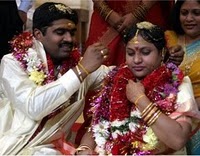
2) Formal education begins for Hindus when the child first writes with the guidance and hand of a guru or teacher.
Taking from this practice, many of the Christian faithful come to the bishop with their child to do the same. This act is "baptized" because the writing consists of some Christian word such as Jesus or God.

3) Lamps are typically seen inside temples. The oil from these lamps is put on the head or neck as a blessing.
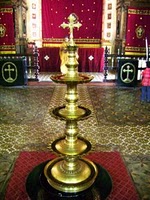
In churches these lamps are also used: The lamp is "baptized" with a cross on top. And when its oil is placed on the head or neck, it's done so in the shape of a cross. Similarly, if one closely inspects the lamp-like post outside churches (also seen in temples), Christian images are found:
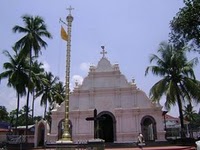
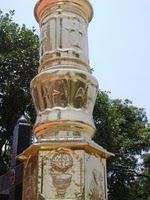
4) Ancient churches reflect architectural styles similar to temples. For instance, St. George Church in Kadamattom has a triangular covered area in front for people to rest and pray at the doors of the church:
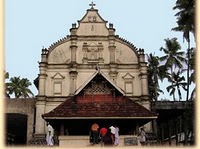
It's built similar to the style of temples:
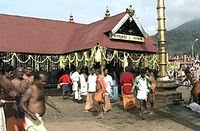
5) Hindu festivals include a long procession through the city stopping at their holy sites, established with an idol, to offer prayers. One of these places is close to where I'm staying. I noticed it at night because of the lamp that's always lit. I later found out that the place is dedicated to their snake god, which means there's snakes around. From that day onwards, as I'm walking through there at night, my ardent prayers are offered to all gods at every step!
Returning to the topic of Hindu processions, the people travel in lines through the city with drums and music.
Church festivals also include these processions, stopping at cross towers throughout the area to offer prayers. The faithful are dressed in white (like Hindus) as drums and Christian music play in the background.
In my visits to temples, it was quite interesting to find these similarities and others between the two faiths. The key point is that Christ can be seen everywhere, reflected even in these "baptized" Hindu practices.
The most noticeable aspect of Hinduism is their respect for other religions. They have no problem praying in churches and taking part in Christian events; the major reason being that they see god in everything. Jesus Christ and His saints are all seen as gods. I wrote earlier about church festivals filled with attending Hindus, especially in large and famous churches. They are the ones who, from my observation, show great faith. And for this, I believe, they will be blessed because they sincerely believe that what they request will be granted.
The typical manner of greeting in Indian culture is bowing slightly with folded hands:
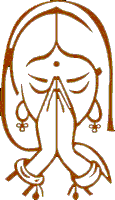
This gesture comes from the Hindu understanding that all are gods. I am bowing and respecting you, o god. Like this, Hinduism respects Christianity.
Let me share with you two personal examples. While we were conversing with a young Hindu mother, the church bell ran as it typically does at 6pm. At that moment, she looks up and silently says "god" in the Indian language. This is the church, not temple bell . . . but this does not matter for her.
Another time I observed a Hindu procession taking place at night. To my surprise, it stopped in front of the church tower, and the one dressed in a decorative Hindu outfit began to respectfully dance in front of the cross tower:
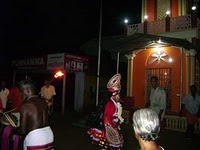
They then left after giving an offering of money.
My point is not that we should start praying in temples. This would be difficult. For instance, I saw this picture in the prayer area of a shop:
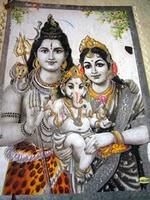
How it looks so similar to Christ and His parents:
![]()
But for Hindus, they actually believe that their god, Ganapathi , came in the form above, which of course is very hard for me to accept.
Nonetheless, Christianity teaches that all of us are created in the image of God, regardless of religion. This is not to say that I'm advocating a universal religion where all gods are accepted. I certainly believe that there is only one God, the God who humbled Himself such that He became one of us to show His ultimate love. And Christ did say, "I am the way, the truth, and the life" (John 14:6), not "I am one of the way's".
On the other hand, this belief must not lead to spiritual arrogance. It is very easy for me to condemn other religions and hold a "me against them" mentality. This is often seen in missionaries today who boldly proclaim: "I am a saved Christian, are you?". Hinduism presents the other side of respecting and seeing God in others. One of my favorite verses in Scripture states: "And now these three remain: faith, hope and love. But the greatest of these is love" (1 Cor. 13:13). Oftentimes we think that faith is most important in one's life, but Scripture tells us that even greater than faith is love.
When I first thought about staying in Kerala for over 7 months, I wondered if it was too long. But the months passed by quickly mainly because of the people I have met. I have seen, learned, and experienced much. Some of these I shared with you in my journals. There are other things which are impossible to put into words. This culture has taught me many things about community and relationships. And the friendships that I have gained are invaluable. Love certainly is the greatest of them all.
Comment by TJ:
Today's Hinduism is an Aryan religion. In the southern states predominated by Dravidians, the Hinduism we experience today assimilated the former religious practices of Dravidians which could perhaps be best characterized by animism. The sarpa kavu (snake forest) is a vestige of the animist practices that survive. So it is questionable whether Christians were converted from Hinduism, esp. if you mean Hinduism as understood today. Perhaps it is more accurate to say that the animist Dravidians assimilated the practices of the immigrants to the region today marked by the state of Kerala. Successors of those who were influenced by the Aryans are the modern Hindus (many of whom practiced Buddhism during an intervening period). Those who were influenced by the Semitic religions became Christians or Muslims. (This is of course a simplistic depiction; the processes of such assimilation have taken several twists & turns.) There is a broader interpretation of Hinduism as not a doctrinal faith but a way of life. If understood in such a sense, an indigenous Christian in India could be considered a Hindu and it is in this light that one ought to see the assimilation of common social rituals into a Christianized context (what you refer to as "baptism").
Thanks for penning your experiences in the blog. Having been raised in Kerala and having lived in the US for nearly two decades, it was very interesting for me to read about your experience of Kerala from the vantage point of a second generation Malayalee discovering his roots.
Table of Contents | Previous Journal(7)
eBooks Home | Travel | General | Humor | Health | Inspirational Articles | General Essays | Sermons | Library - Home | Baselios Church Home
-------
Malankara World
A service of St. Basil's Syriac Orthodox
Church, Ohio
Copyright © 2009-2020 - ICBS Group. All Rights Reserved.
Disclaimer
Website designed, built, and hosted by
International Cyber Business Services, Inc., Hudson, Ohio